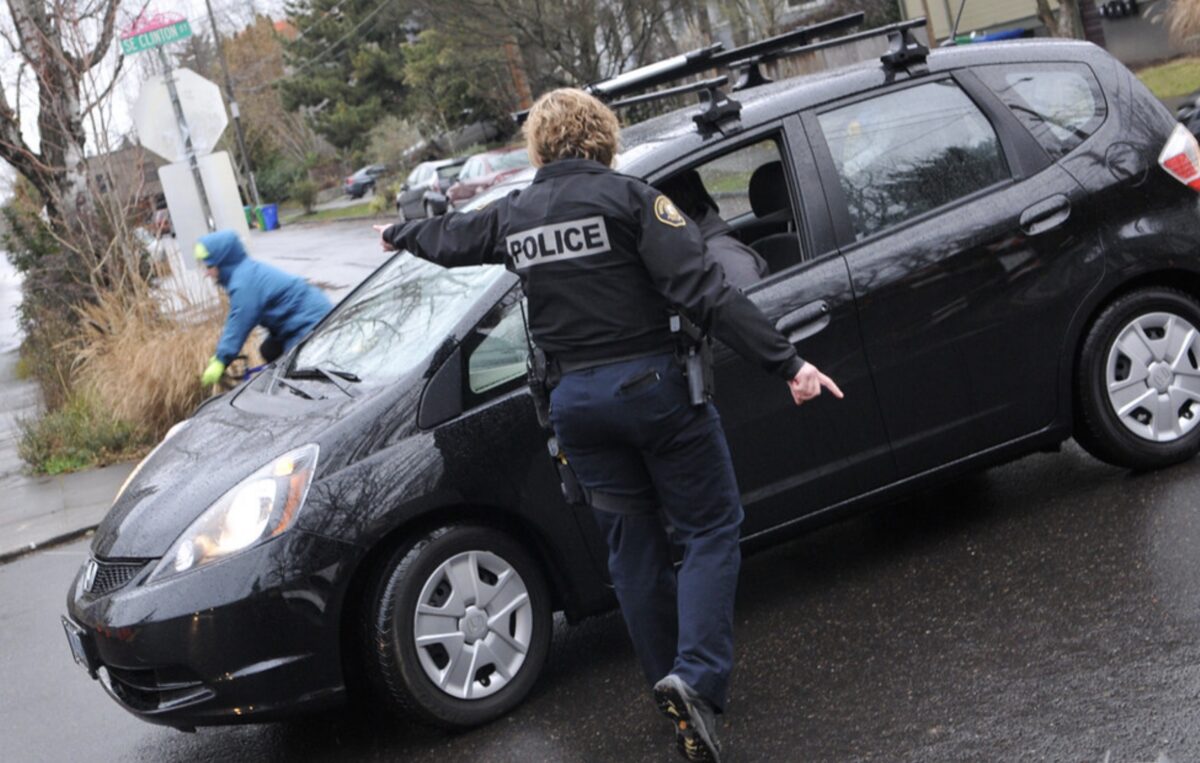
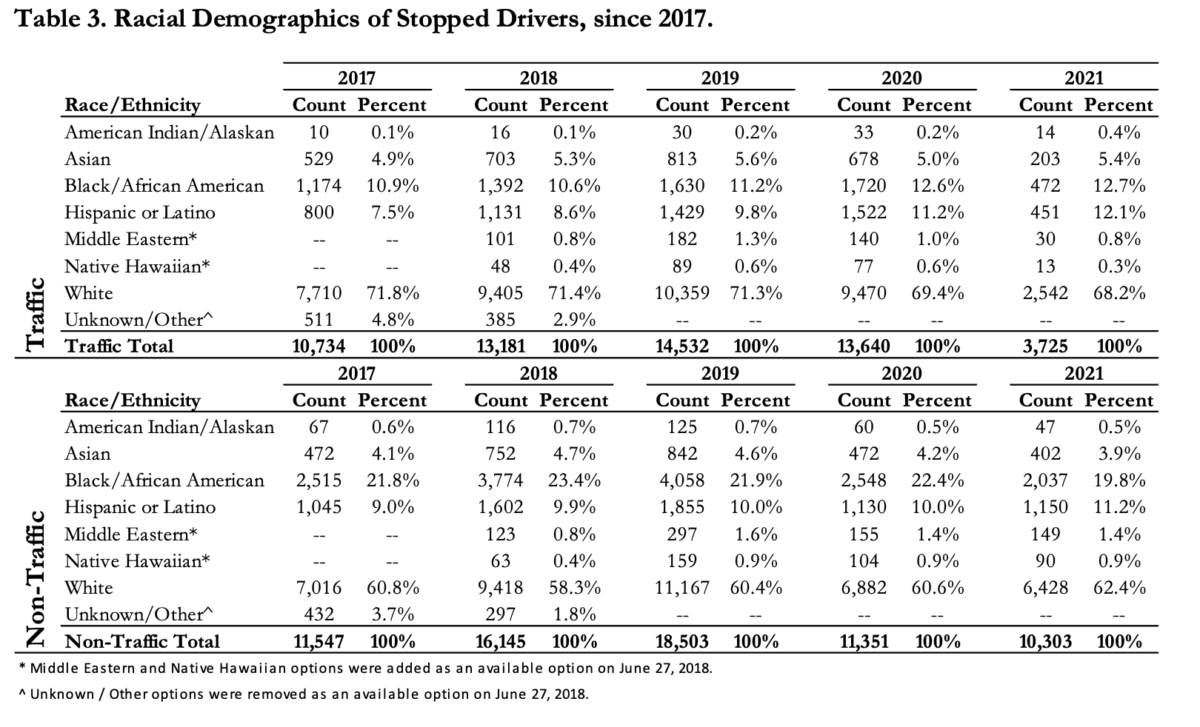
Being stopped in traffic is the most common way most people come into contact with the police, but we don’t all experience those stops equally. In Portland (and throughout the United States), people of color are overrepresented in traffic stops, with Black people experiencing the most drastic effects of this bias. And this is more than an inconvenience: Black people across the country have been killed by cops using lethal force during otherwise routine traffic stops.
As a result, advocates have taken on this issue as both a racial and transportation justice cause, and Portland officials have indicated they want to make a change. Last summer, Mayor Ted Wheeler and Police Chief Chuck Lovell directed Portland police officers to make fewer traffic stops, especially for offenses deemed low-importance, where racial bias is more prevalent.
“We need to focus on behaviors that result in serious or fatal crashes, such as speeding, driving while impaired, distracted driving, etc.” Lovell said in a press release last year. “Stops for non-moving violations or lower level infractions will still be allowed, but they must have a safety component or have an actionable investigative factor to it.”
A report on 2021 traffic stops released by the Portland Police Bureau (PPB) earlier this month sheds light into what – if anything – has changed in the year since. The big takeaway? Despite a serious drop in traffic stop rates, large racial disparities remain.
PPB’s traffic stop rates were way down in 2021 – the report says PPB officers “performed 44 percent fewer driver stops and 80 percent fewer pedestrian stops than in the prior year.” But this is not necessarily as a result of Wheeler and Lovell’s instructions, and it didn’t appear to make an impact on the racial biases shown against Portlanders of color. Instead, it appears to be because of a staffing shift that sent the Bureau’s Traffic Division into disarray.
Before 2021, there were two groups of officers – from the Traffic and Non-Traffic Divisions – making roughly the same number of traffic stops each year for different reasons. The stated mission of the Traffic Division is to “address behaviors of road users, including drivers, bicycle riders, and pedestrians, that might lead to a collision.” The Non-Traffic Division’s goal “primarily relates to the reduction and prevention of violent crime in the City” and involves “discretionary traffic stops to contact potential subjects of interest.”
These discretionary stops are often made for offenses Wheeler and Hovell deemed “low-level” – i.e., an expired license plate or missing tags. They also leave a lot more room for officers to use their own – potentially racially biased – judgment. Even after Wheeler and Lovell guided officers to avoid those stops, the bulk of Non-Traffic Division stops were for offenses deemed minor.
Differences in calculating racial disparities
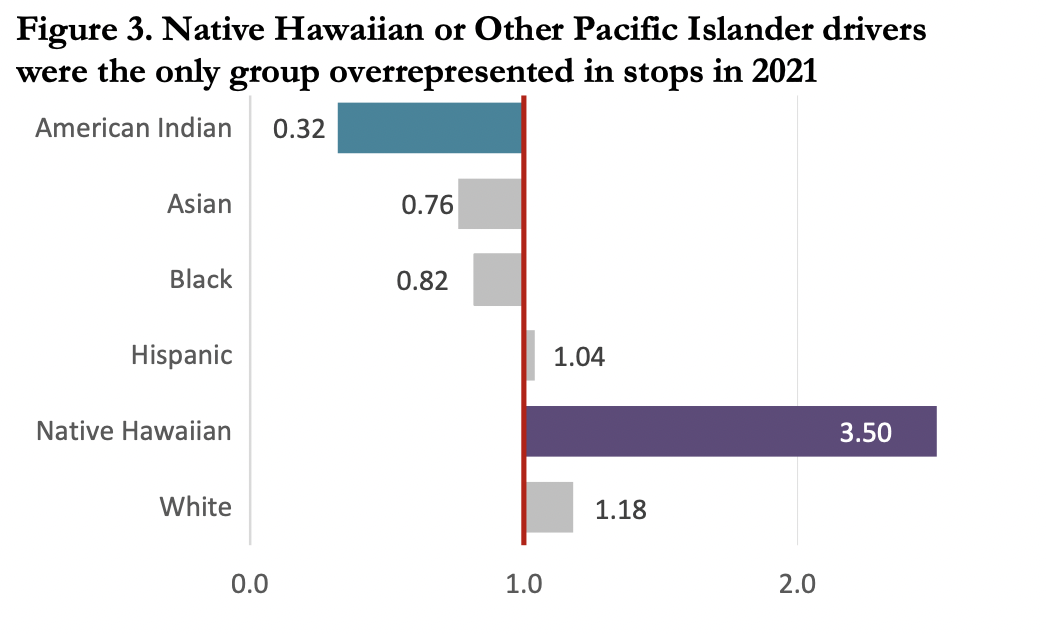
PPB uses its own benchmarks to compare their data on citywide racial demographics to calculate disparities. Recent census data indicates Portland’s Black population sits at about 5.9% of the total. Even though the actual number may be slightly higher due to census counting errors and a growing population, this percentage is generally accepted and has been used in the past to indicate racial profiling within PPB traffic stops.
According to the report, Black people made up almost 18% of the population stopped in traffic in 2021 – meaning they are overrepresented threefold. But PPB’s internal data says otherwise.
PPB uses injury collision rates – the demographics of people involved in injury collisions investigated by PPB officers – as a benchmark to use when comparing their traffic stop data to the general population. For the Non-Traffic Division, PPB uses the demographics of crime victimization rates as a benchmark. Both of these benchmarks (see charts below) present a far higher percentage of non-white Portlanders than actually live here.
According to their internal data, Native Hawaiian or Pacific Islander drivers were the only group overrepresented in PPB traffic stops in 2021, and otherwise, PPB officers did not show racial discrimination within their traffic stop procedures. But given the lack of substantial police oversight within the Bureau and its history (and ongoing demonstration) of institutional racism, some people have called this practice into question.
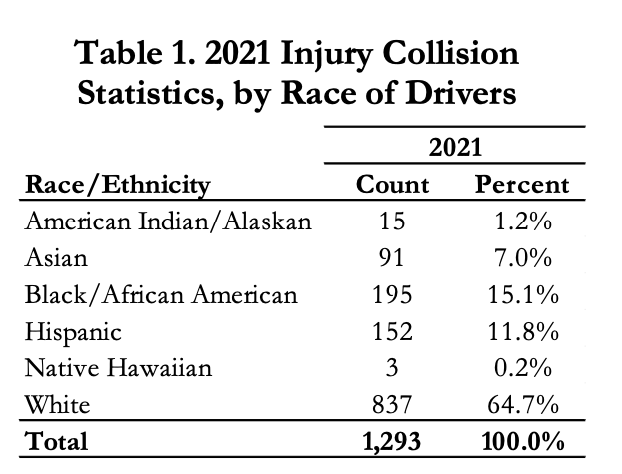
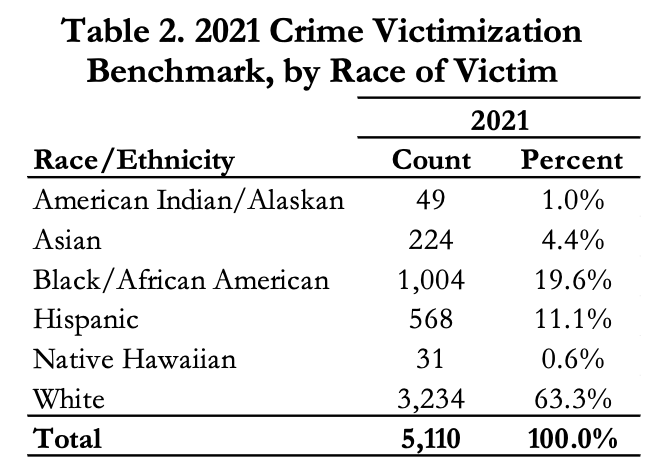
What’s next?
The report states the “slight declines witnessed in Minor Moving Violation and Non-Moving Violation stops” are “an encouraging step and demonstrates the Bureau’s willingness to act and change.” But the racial disparities have not improved, which Lovell himself has acknowledged.
It’s unclear the effect the Wheeler and Lovell’s instructions and the PPB staff shortage had on Portland’s traffic crash fatality rates, which were exceptionally high last year and aren’t too much better this year. Even if PPB officers had directed their attention to the most dangerous offenses, data suggests increased policing doesn’t work as a method of preventing traffic crashes and deaths.
Instead, advocates say infrastructure changes are what’s needed to improve street safety. Some advocates are in favor of solutions like traffic camera speed enforcement, which can now be processed without costly and time-consuming police involvement.
Read the PPB’s full report here.



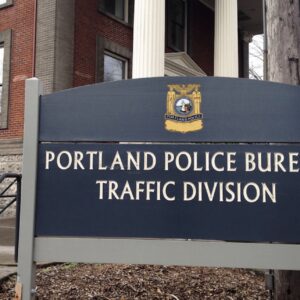
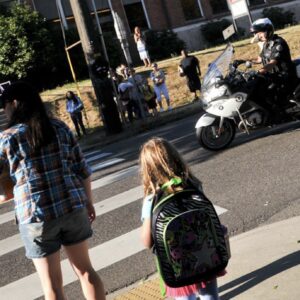
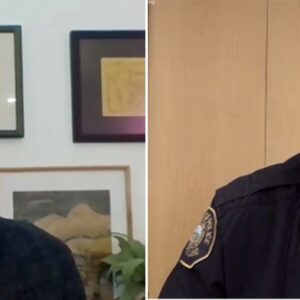
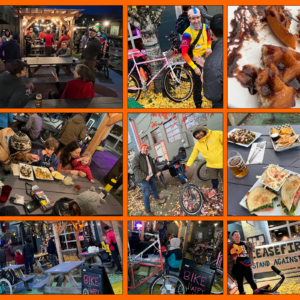
Thanks for reading.
BikePortland has served this community with independent community journalism since 2005. We rely on subscriptions from readers like you to survive. Your financial support is vital in keeping this valuable resource alive and well.
Please subscribe today to strengthen and expand our work.
Let’s see if I’ve got this right…
So, prior to 2021, you’ve got half the traffic stops being done by the Traffic Division; the ones intended to address dangerous behavior. And the other half of the stops appear to be “discretionary” and are (ostensibly) intended to address violent crime.
Then, in response to budget cuts (again, ostensibly), you eliminate the Traffic Division, but allow the discretionary stops to continue, in the interest of addressing violent crime.
And now we have the results… Traffic stops are down by nearly half (makes sense, given the above). Traffic injuries and deaths are up. Violent crime is up. And if you use actual population numbers rather than just picking your own denominator, traffic stops are just as racially biased as before. And, anecdotally at least, driver behavior is worse than ever.
Here’s a crazy idea. How about we cut back on the “discretionary” stops, which by all signs are still racist and aren’t actually doing anything to help traffic behavior (because they aren’t intended to). Then we can reinstate the Traffic Division, who can then go back to just stopping people based on who is actually a danger on the road rather than the color of their skin. Crazy, right?
Using population as your denominator doesn’t make sense. What matters is the infraction rate, which is hard to measure directly, but can be estimated indirectly.
(Otherwise, you have to explain the wild discrimination the police are committing against males, who represented 68.3% of traffic stops in 2021.)
But otherwise, I agree with you. The discretionary stops are the problem, not the traffic stops.
People think equal outcomes = equality.
A group is overrepresented if they are being stopped more than the level of violations they commit. The data presented above shows that African American drivers represented 15.1% of the traffic injuries, which is probably a good surrogate for the rate at which that group commits serious traffic violations. Since that group represented only 12.7% of stops, they are probably under represented.
Hispanics are slightly overrepresented (11.8% vs 12.1%), but whites much more so (64.7% vs 68.2%).
The data does not support the thesis of this article.
Hi Watts, thanks for this comment. I understand your line of thinking here and want to explain the process I used to analyze this data. You’re right about the distinction between discretionary and traffic stops — but in this case, they’re all characterized under the same umbrella. I will respond to you in more detail soon – just wanted to let you know.
It would be awesome to include some justification for ignoring the likelihood of police interaction in areas of the city subject to the greatest numbers of 911 calls for property and violent crime and their demographic makeup. I.e. Is it remotely plausible that individuals who don’t much care about laws respecting property rights or those of prohibiting violence on others, also care much less about laws for operating a vehicle? Further, is it remotely plausible that areas requesting police presence the most frequently may also end up with those police enforcing the various laws they are supposed to with greater frequency in those areas?
This would certainly contribute to data suggesting a racial bias, but as Watts notes, a racial bias can’t be the reasonable conclusion.
The Injury Collision and Crime Victimization benchmarks provided by PPB do give an insight into community demographics that are different than census data, and in some cases those benchmarks are more relevant. A group of people being stopped more than census data would suggest is appropriate does not necessarily mean that group is being discriminated against. To use Watts’ example in an above reply, men are stopped in traffic at a higher rate than women – because they speed at higher rates. There are intricacies here that would require more analysis (one could argue a number of reasons men drive faster than women on average) but some of the numbers are pretty cut and dry.
What this article concerns, however, is the difference between traffic stops and “discretionary” stops which, as you point out, are problematic because they allow more room for individual interpretation. When Chief Lovell and Mayor Wheeler gave their directive last year, they specifically asked officers to make less of these discretionary stops. As you’ll notice on the chart, Black people represented almost 20% of the stops made by officers in the Non-traffic Division this year. And because of the staff shortage, this division did the bulk of these stops.
So, in short: PPB officers did not reduce their discretionary stops by a significant enough margin to rectify the large racial disparities that exist within that procedure. And data carries the baggage of the society that it’s measured in. PS’s above comment, loaded with racism,
is actually a good example of why this kind of data should not necessarily be taken at face value. If a police officer wrongfully thinks a certain demographic of people “don’t care much about laws respecting property rights or those of prohibiting violence on others,” that does not give them the right to baselessly stop them in traffic for non-moving offenses, going against orders to do so.
Regardless, Lovell himself admitted problems remain with the racial disparity in traffic stops. And every other piece of reporting about racism within PPB’s traffic stop procedure uses census data as a comparison. It’s commonly accepted that racism plays a role in police traffic stops. While I’ll grant that the unique makeup of the Traffic vs Non-Traffic Divisions in 2021 added some complexity here, I did not skew data to get a certain narrative across.
You just slipped your (unsupported) conclusion back in as if it were proven. It’s not. We don’t actually know if there is a racial disparity.
I primarily focused on traffic stops because 1) I have a level of discomfort with pretextual stops due to the lack of individualized suspicion; 2) it’s what was mentioned in the article title; 3) the metric against which to measure bias seems clearer to me than with pretextual stops; and 4) traffic stops are often claimed to be biased (very often, and by many, in this forum, and seem more relevant to the conversations we typically have).
That’s not what PS said: they specifically referenced “individuals”, and their argument that disrespect for the law in one area may translate to disrespect in another is hardly irrational. Calling that post “loaded with racism” requires more than just an assertion without explanation. I’ve re-read it 4 times now and I just don’t see it. Racism is a serious accusation.
PS: Just to correct one misstatement: “baselessly stop them in traffic for non-moving offenses”; pretext stops require an underlying offence for the stop, even if it is one that the officer might otherwise overlook. Again, not defending the easily-abused practice, but let’s be clear about what it is.
I’m not going to argue with you about the racial disparity in discretionary stops, but I will say that I am not the first or only person to write an article claiming there are racial disparities within traffic stop procedures. The PPB Chief said it himself.
And I will say once again that all of these stops are designated as traffic stops. I understand that’s confusing and may make a clarification. In the report, they refer to these as driver stops, which may be more direct. Either way, they’re all considered traffic stops, even if they’re for “non-traffic” offenses. And since the Traffic Division has been gutted, this distinction is even more muddled than usual.
Finally, given the context of the conversation here, PS’s comment made an implication about people who come into contact with the police more, and further jumped to a conclusion about their ability to drive a car. I did not call this individual racist. I do feel comfortable saying that was a racially loaded comment to make considering the proven history of overpolicing in Black communities across the country. Cops do choose to pull over Black drivers for reasons that they may have overlooked if a white person was driving the car, and they use similar excuses. People have been killed as a result.
I don’t claim that you’re wrong, only that the data you presented refutes your case. There may well be other data that is convincing, and perhaps Chief Lovell has seen that. I haven’t.
That said, all of the reporting I’ve seen on this topic over the years (including from the usually thoughtful OBP) cites the same report and follows the same reasoning this article does, without any additional analysis or information. I think it is an understandable mistake, but it is still a mistake.
PS’s chain of reasoning is that there are communities that call 911 for service more than others, so it may be possible that the police pay more attention to those areas (which, arguably, they should), which might (in my words) contribute to a sense of over-policing. PS never said anything about ability to drive, only that disregard for traffic laws may correlate with disregard for other laws.
Again, none of this reasoning is racist, and it’s debatable whether it even describes racism. You did not call PS racist, but did say their post was “loaded with racism”, and while you are right to note the distinction, it seems a pretty minor one to me when using such inflammatory terms.
If what I said is actually racist, don’t you have to delete the comment? Isn’t that a rule here, there is a zero tolerance policy for racist comments? Or is something being “loaded with racism” different than being actually racist? Maybe Jonathan can opine here on where we should be drawing the line between calling comments racist that obviously aren’t, and actual racism?
“What, you can’t say ‘Black people don’t care about the law’ without getting called racist anymore??”
Not what he said at all but I am sure you feel better about yourself…
“ Is it remotely plausible that individuals who don’t much care about laws respecting property rights or those of prohibiting violence on others, also care much less about laws for operating a vehicle?”
Where’s the part again about “black people don’t care about the law?” Such a sentiment is not even implied by PS’s comment.
BBCC, your reading comprehension skills are non-existent. Your asinine retort is why journalists, like Taylor Griggs, should be much more careful and thoughtful with how they articulate the difference between a comment “loaded with racism” versus calling out someone as racist. PS’s comment was neither.
We have a murder and crime epidemic here and that is not hyperbole and you write like you are doing a research paper…
Another murder last night, 51 so far this year.
I guess you must not care living where you do or whatever, but crime is a problem that is getting worse, not better, and worse all the time in the neighborhoods that you don’t live in obviously because it is not an abstract issue.
I don’t give a crap about “discretionary” stops are whatever statistics you present.
People are dying, maybe we should look at solutions.
*Probably*? I can think of reasons to doubt that!
The relatively higher % of black people involved in traffic accidents could also be explained by the disproportionate amount of time black folks spend driving in areas with more dangerous infrastructure (blind corners, high speed roads, etc.), or having older cars without modern safety mechanisms like automatic braking or blind spot warning, or non-black people being more likely to want to report an accident to the police if a black person is the other driver.
You’re guessing. I wouldn’t make that leap.
You’re guessing as well.
The unfortunate thing is, everyone can interpret data to fit their own narrative, good or bad.
I think it’s good that people can respectfully post opposing opinions to articles that claim to have one interpretation. Ultimately, you have to decide for yourself, which, if any, opinion you agree with or form your own.
Yup, that’s exactly what I’m saying — you could offer many different explanations for the race breakdown we see in that table (including Watts’ claim that black people probably commit serious infractions more often), and claiming any one of these explications is “probably” true is jumping to a conclusion with virtually no evidence.
The burden is on those trying to make the case that the stops are disproportional to explain the evidence. Without such explanation, the claim is just another unfounded accusation.
I’ve found that even when driving on dangerous streets, following the law *greatly* reduces my chance of crashing and the risk of getting hurt if I do. Also, by focusing on injury crashes, you remove some of the reporting bias that you suggest may creep in.
It’s not impossible you are right, of course, but it seems much more likely that people who crash often don’t habitually follow driving law (which is specifically intended to prevent crashes). I’d be happy to consider any evidence that better explains the 3x crash rate absent differing rates of driving violations. You present none and the article presents none.
Fundamentally, if you’re going to claim disproportionate treatment, as this article does, you can’t just claim that the fairly solid evidence disputing it might possibly be wrong, and therefore the case is proved. The case is not proved. In the absence of more evidence, the case is refuted.
Using a population denominator is more naive — it makes no assumptions about racial differences in underlying infraction rates, which we could consider a null model. Your/the PPB’s decision to use crash-involved populations as a denominator is more opinionated — it assumes that the rate at which police are summoned to injury-related crashes closely mirrors the underlying rate at which traffic infractions happen. As a Bayesian, I believe the burden of evidence falls on the party advocating for the more opinionated causal model & prior. That means it’s up to you/the PPB to demonstrate that the observed distribution of crash rates by race closely mirrors the underlying distribution of infraction rates by race.
That is possible! I’d be very open to looking at evidence that adjusted for road & car features and looked at infraction rates by race. But for now, I don’t think that a black driver and a white driver on the same road in the same car would drive significantly differently, which is your fundamental claim.
The burden falls on those making the claim.
I am claiming nothing, except that those making the claims that stops are disproportional have offered no explanation for the evidence to the contrary.
As I said before, the claim of bias could very well be true (it certainly fits with my personal biases), but it is an unsupported allegation at this point.
I feel that you’ve already arrived at your conclusion, and are now trying to figure out how to support it, because, by golly, it just has to be true.
Maybe it’s not.
You see, we’re both making claims, but mine is more naive. Black people make up about 6% of the population and 18% of those stopped by police. That means they are stopped disproportionately — based on census data, not a sample. You are making the claim that once you adjust for infraction rates, that disproportionality disappears, and further that you can estimate the racial distribution of traffic infractions using police crash statistics.
We have two possibilities: that crash rates reflect an underlying adherence to traffic laws, or that they don’t. You seem to be arguing that they don’t. If that were true, then it would follow that following traffic laws does not reduce one’s likelihood of experiencing a crash, which strikes me as an absurd (but theoretically possible) conclusion.
Would you also argue that the significantly elevated rate at which young men crash tells us nothing about how well they* follow traffic laws (such as speeding)?
At some point you need to make a judgement to draw a conclusion. Clearly our judgements differ. But then significant parts of this country believe things I find highly unlikely.
*In aggregate; the crash rate tells us nothing about how any individual young man drives.
Are you willing to apply the same approach to each instance of disproportionate police interaction regardless of underlying demographic? Might be a good way to test how committed you are to the data and not to a preconceived output you’re just looking for data to support.
Excellent coverage Taylor, thanks for the quality journalism here.
Wish The O or TV news did half this kind of analysis. (OPB and WW can’t do it all alone!)
The median black Portlander is 6.6 years younger than the median white Portlander, per the US Census Bureau. How much of the racial delta is explained by differing age distributions?
Good god this blog has really gone downhill. This is the rot that progressive social justice activism produces.
BikePortland: “Hey, maybe we shouldn’t disproportional harass people of color”
Matthew: “THIS IS PROGRESSIVE SOCIAL JUSTICE ROT”
yeah ok buddy
Watts: “Hey, maybe we shouldn’t make claims of disproportionate harassment of people by race in the face of evidence it’s not true.”
Whatever your perspective, monocausal explanations are rarely a sign of intellectual openness and rigor.
If we don’t have equal outcomes, it is racist.
Also, “cultural diversity”. You can’t expect equal outcomes with diverse inputs.
Using census data as a benchmark doesn’t really make sense, there are plenty of people who drive on Portland’s roads who are not city residents.
Yeah, the surrounding Portland region is very well known for high populations of minorities… \\s
The difference is starker still if you zoom out to the state level, with the median black Oregonian 8.1 years younger than the median white Oregonian.
Youth is the single biggest risk factor for dangerous driving, so this data might help us understand some of the the disparity in injury rates for people of different races, and some of the differing traffic stop rates, too.
The most stunning aspect of the data to my eyes is that traffic stops dropped from 76% from 2019 to 2021, down to 3,745, or 10.2 per day across the entire city.
Way more Portlanders had their car stolen last year than were pulled over for a traffic violation. Is it any wonder that auto deaths and injuries are spiking?
Don’t worry, PBOT is going to take bold and aggressive action! Their next move is to come up with signs that say “pretty pretty pretty please, dont speed pleassssee?” and distribute them on high crash corridors. #ZeroVision
I have some things that I am curious about here:
At least in theory, it seems reasonable that policing practices should be proportionate to disparate rates of crime, but this actual methodology depends on assumptions that are at best dubious and at worst obviously dumb or actually contradicted by data.
It’s also really interesting to look at the absolute number of stops for black drivers between traffic and non-traffic divisions, where for 2017-2020 the non-traffic division stopped more than twice as many people as the traffic division. That suggests that two out of three traffic stops for black people over that time period were pretextual stops.
I don’t really think that traffic stops for dangerous driving behavior are *that* effective of a tool just because they don’t happen consistently enough to be as good of a deterrent as automated speed cameras etc, but at least those stops are targeting behaviors that are actually risky. It seems pretty obviously wrongheaded to devote twice as much effort to pretextual traffic stops that don’t seem to correlate particularly well to solving or preventing crimes.
I’m not going to defend this claim, but I think I can explain it. It is pretty well established that most crime is “in-group” and infrequently crosses racial lines. From that, we can surmise that the victim demographics approximate that of perpetrators.
It is not a sign of bias if the police are stopping groups in proportion to the underlying offence rate (and might be a sign of bias if they didn’t). Ergo, traffic stops should be proportional to the share of crime victimization.
It’s not. The expired tags are a pretext for the stop, which is really about trying to see who is in the vehicle and what they’re up to. I am uncomfortable with these sorts of stops, as there is no individualized presumption of guilt. But the police would argue they are not disproportionately subjecting any particular group to this sort of (unsavory) treatment. And if the driver was driving illegally, perhaps a stop is warranted.
I think this is the operative question. Even in the absence of racial bias, I think it’s important to understand if the practice has merit.
On the other hand, if the stops reduce the number of unregistered vehicles on the street, they’re not all bad.
Thank you, Bill, for this thoughtful comment. I couldn’t go into as detailed analysis in this article as I would like to (and would certainly benefit from the help of someone better equipped to data analysis than I), but these questions were all on my mind as well. It is not news that Black Americans are disproportionately policed, and it’s not subjective to say they are overrepresented in traffic stops. Your points are very well-put and I hope they inspire conversation.
Black people were 38% of the people murdered in Portland in 2021…
That should be the number that concerns people.
Taylor, thanks so much for reporting on this. I see a lot of comments where people say or suggest that Black people and other people of color get pulled over more often for “other reasons,” like age or driving behavior. This is a very common thing in Portland, where people want to explain things that seem racist by suggesting it’s something else unrelated to race.
What’s quite interesting is that a recent study showed that racial disparities in police stops at night — when police can’t see the driver’s race — decrease dramatically. When police can’t see that a driver is Black and make decisions based on driver behavior and the car, police are much less likely to pull over a Black driver.
Racism is a systemic problem in policing. That’s incontrovertible.
With the majority of shooting and murders in the black gang population in Portland, what do you suggest police do?
38% of murders are black men with a population of 5% in Portland.
Serious question, my grandchildren are mixed race, I want them protected…
Protected from whom? Black people in Portland are at great risk any time the police get involved. The idea that police protect us is very much a white idea. That’s not the experience of many people of color. I would hope that your grandchildren are learning this from their parents, as my kids learned from me.
Protected from people shooting at them…
You are oK with 50 young black men a year being murdered in the city?
You are apparently lucky to live in the right neighborhood.
Unbelievable condescension towards crime victims.
81% of black Americans want police to spend the same amount of time (or more) in their area, per Gallup. To insist otherwise is an act of supreme condescension.
Who would have guessed that when you get right down to it, most people want the same things, regardless of race?
We are all stronger when we work together; don’t give in to those who would divide us.
You project a lot… How do you know who the black parent or grand parent is? You have no idea what my race is.
As The War On Cars explored in their episode, The Automotive Police State, many of these issues were created or exacerbated by giving armed police jurisdiction over traffic enforcement. If PPB is so overworked and seemingly unable to stop discriminating, we should remove traffic enforcement from their duties entirely, and get them back to investigating real crimes with real evidence.
The above data shows that we’re well on our way down that path. How would you say that’s going for us?